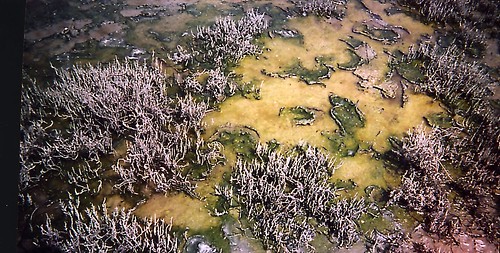The Mugu marsh has many micro-habitats that support a variety of wetland life. Mugu marsh is also a Naval Base which scrutinizes all who enter. Only those with official business on the Base can step foot within the gates. This is a good thing for plants and animals that have been extirpated from their other wetlands, beaches, and salt pannes ...they have a small safe place for a while.....
People, no matter how thoughtful, impact these sensitive areas. Scientists who study the environment must tread lightly. SUV's and ORV's never ever - I repeat - never tread lightly. Tiger beetles live in sand in mud and eat the flies, ants, bees and other beetles that cross their holes in the soil. As adults, disturbed areas in the marsh, along beaches, sand bars, along rivers and streams, salt flats, run until they are torn up for buildings and roads. So many spots for tiger beetles, and the animals we support near water have been lost to the industry of people.
Wetlands were the trash bins of cities.
Now, the wide open areas are for off-roading.
Insects that live near or develop in water can carry disease, but most do not. The insecticides that kill the mosquiotes and black flies kill other insects as well. And,.... DDT still hides as a poison in the mud.
People's buildings, even miles away, impact the beaches and marshes because water flows downhill. People who spray lawn grower and pesticides might as well pour those chemicals directly on us! Everything that may be poured, excreted, spilled, leaked, regurgitated or purposely put on the streets ends here. Beaches and marshes are so full of the chemicals of people, the water in the mud can cause animals to be sick, be less fecund and die early deaths.
The marshland used to protect the oceans by filtering the water that flowed through the upper watershed, but there are more people pouring and spilling then there are natural filters to filter. Even if the people filter the water (supernatant) that flows from their streets from the urban sludge, people must find ways of disposing of the 'matter' safely. Increasingly, there are fewer places that can be used as dump sites that are at a distance from urban/suburbia. The Army Corps of Engineers have a special division that supervises the Department of Defense's dump sites (Formally Used Defense Sites - FUDS) but are concerned that urban development is growing faster then they can assess and maybe clean up. The sprawl will be at the edge of many areas set aside and made inaccessible because of radioactivity, explosives, and other toxic materials used for war.
.................I digress..........
This is a picture of Salicornia surrounded by diatom mats. Diatoms are silicon 'shelled' algae that will grow together on the soil when tides of the ocean fill the marsh and stands for a time. Tiger beetles can run across the slick of water to catch Ephidirdae feeding on the dyeing vegetation. The diatoms grow greenish, then turn yellow then black. Pink fungus grows with the diatoms in the mud. It may look radioactive, but it isn't.
Thursday, May 12, 2005
diatom cover
Subscribe to:
Post Comments (Atom)

No comments:
Post a Comment